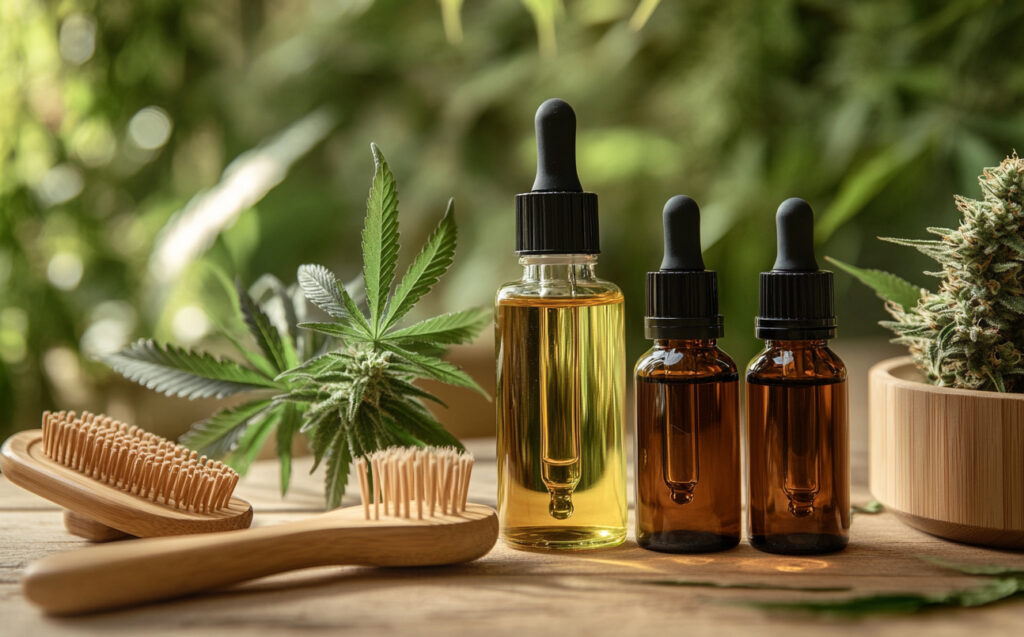When it comes to cannabis you’ve likely heard of its main components (cannabinoids) THC and CBD. If you’re reading this article, it’s a good chance you already know about some of the differences between THC and CBD. There’s been a lot of interest about all the amazing things CBD can do! It’s been popping up in all kinds of products, from oils, capsules, gummies, beverages, and even personal care products like creams and lotions. What you may not have considered (yet!) is adding CBD into your hair care routine. Here, we will review and summarize the latest research on CBD and the endocannabinoid system.
Cannabinoids are a complex group of molecules that include phytocannabinoids, endocannabinoids, and synthetic cannabinoids. CBD (aka cannibidiol) is one of the major cannabinoids produced by cannabis plants, known as phytocannabinoids. The other major phytocannabinoid is of course THC, and there are several other phytocannabinoids that have been identified including CBG and CBC. These so-called minor cannabinoids are usually present in very small amounts compared to THC and CBD. Your body can also make its own cannabinoids called endocannabinoids. The two main endocannabinoids that have been identified so far are anandamide (AEA) and 2-arachidonoylglycerol (2-AG). They are involved in many functions of the body, including, but not limited to, memory, sleep, pain control, and even the immune system. Lastly, synthetic cannabinoids are not naturally occurring, but are instead produced in a lab. Regardless of their origin, all cannabinoids interact with our bodies’ endocannabinoid system, often referred to as the ECS.
The endocannabinoid system was discovered in the 1990s. It can be defined as a complex cell-signaling system that helps regulate some important functions in your body, including sleep, immune system, memory and mood. Even though it was identified fairly recently, the ECS has always been part of our bodies and it plays a very important role for everyone whether or not they use cannabis. The ECS consists of the aforementioned endocannabinoids, as well as cannabinoid receptors and proteins called enzymes. Your body produces endocannabinoids as it requires them. When endocannabinoids bind to a cannabinoid receptor, it produces an effect that is dependent on the type of cannabinoid, the type of receptor, and where the receptor is located. There are two main cannabinoid receptors are CB1 and CB2. CB1 receptors are found primarily in the central nervous system which is the brain and spine, while CB2 receptors are found mostly in the peripheral nervous system, which is everything else outside of the central nervous system. The role of enzyme proteins in the ECS is to break down and eliminate endocannabinoids when they are no longer required.
The ECS is quite complex and its full scope is not fully understood by experts. It is now known that beyond cannabinoid receptors CB1 and CB2, cannabinoids are also able to activate other types of receptors all over the body. Therefore, cannabinoids may cause their effects through CB1/CB2-dependent and independent receptor mechanisms, or a combination of both. (Handbook of Cannabis and Related Pathologies, Biology, Pharmacology, Diagnosis, and Treatment, 2017, Pages 671-679.) Furthermore, it is becoming clear that the ECS performs key functions within processes as diverse as pain sensation, inflammation, immune response, muscle and bone growth, skin health, digestion and much more (Int J Mol Sci. 2018 Mar; 19(3): 833).
The major phytocannabinoids THC and CBD produce their effects by interacting with the ECS. Unlike THC, CBD is not known to cause euphoria, intoxication or to become addictive. The therapeutic potential of CBD is wide ranging and continues to be fully investigated (Expert Committee on Drug Dependence, 2018). CBD in sublingual, oral, inhaled and topical products are widely available legally in Canada. In the United States, CBD in oral form is FDA approved for treatment of epilepsy. It is estimated that as many as 14% of the United States population has tried CBD products. (Corroon & Phillips, 2018).
We are still learning just how CBD interacts with cannabinoid receptors and other types of receptors in the body. Many believe CBD prevents endocannabinoids from being broken down, allowing for greater amounts circulating within the body. It is also possible that CBD binds to receptors that are yet to be discovered. Additionally, research shows that the concentration of CBD determines its effects at a particular site. When applied topically (directly onto the skin), CBD reaches the endocannabinoid receptors on the skin and hair follicles where it interacts with CB1, TRPV1, and TRPV4 receptors (Szabó et al., 2017). A threshold effect has been observed where a certain concentration may have one effect, and a higher concentration can have an opposing effect. That is why it is important for products containing CBD to be thoroughly researched and formulated by experts so that they actually produce the intended result. However, significant adverse events have not been attributed to topical use of CBD (Bìró et al., 2009; Tóth et al., 2019).
In summary, when CBD use is backed by research and in the hands of competent formulators, it can be a very interesting therapeutic ingredient.
